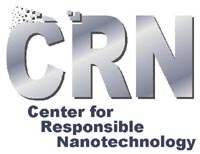Home > Press > Nanotechnology's Radical Future Discussed in Australia and New Zealand
Nanotechnology's Radical Future Discussed in Australia and New Zealand

Posted on October 05, 2006
Disruptive change triggered by nanotechnology was on the agenda for a recent three-week speaking tour of Australia and New Zealand conducted by Mike Treder, executive director of the Center for Responsible Nanotechnology (CRN). Between September 2 and September 21, he gave public lectures and held small group discussions on the subject of 'Disruptive Abundance: Nanotechnology and Human Life' in twelve cities. "We had big audiences everywhere I went -- overflow in some places," said Treder. "People were very interested to hear about the profound impacts that advanced nanotechnology will bring to society."
Treder gave public presentations at the Australian National University in Canberra, the capital city of Australia, and at the University of Western Sydney. He also held seminars with university students and faculty in both locations. In Canberra, Treder met with Australian government officials to discuss that country's plans for a national nanotechnology strategy. In Melbourne, he made a presentation to a group of scientists and researchers from Monash University and from Nanotechnology Victoria, the organization that sponsored his visit to Australia.
An article (link) published by the Australian Broadcasting Corporation said, "Within 15 years, desktop nanofactories could pump out anything from a new car to a novel nanoweapon, says a technology commentator… While molecular manufacturing is not yet a reality, Treder says researchers are already working on building molecular-scale machines that could eventually move atoms around to make products."
Public lectures were given in nine New Zealand cities by Treder just prior to his arrival in Australia. He was the featured speaker in the annual Pickering Lecture Tour, presented by the Institution of Professional Engineers New Zealand (IPENZ). "Mike's presentations generated a lot of interest in the future impact of nanotechnology across the country," said IPENZ's Kathryn McGavin.
Progress in nanotechnology eventually will make it possible to build a wide range of products atom by atom, from the bottom up, using nature's fundamental building blocks, according to Treder. This will result in a manufacturing revolution, offering the potential for huge gains in quality of life, reductions in poverty, clean energy production, vastly improved infrastructures for computing, communication, transportation, and more. However, it also could lead to severe economic disruption, conflicts over intellectual property, omnipresent surveillance, and a potential widening of the gap between rich and poor. Even more ominous is the possibility of a new arms race.
"No one knows for sure how soon all this will happen," said Treder. "But our analysis suggests it will be sooner than most people realize. The cost of not being prepared for such disruptive change could be catastrophic. It's urgent that we invest more in understanding the impacts of this powerful new technology."
About the Center for Responsible Nanotechnology:
The Center for Responsible Nanotechnology, a non-profit think tank concerned with the major societal and environmental implications of advanced nanotechnology, is headquartered in New York. CRN is an affiliate of World Care, an
international, non-profit, 501(c)(3) organization.
For more information, please click here.
Media Contact:
CRN: Mike Treder
Executive Director
+1 718 398 7272
mtreder@CRNano.org
Copyright © Center for Responsible Nanotechnology
If you have a comment, please Contact us.
Issuers of news releases, not 7th Wave, Inc. or Nanotechnology Now, are solely responsible for the accuracy of the content.
| Related News Press |
Preparing for Nano
![]() Disruptive by Design: Nano Now February 1st, 2019
Disruptive by Design: Nano Now February 1st, 2019
![]() How nanoscience will improve our health and lives in the coming years: Targeted medicine deliveries and increased energy efficiency are just two of many ways October 26th, 2016
How nanoscience will improve our health and lives in the coming years: Targeted medicine deliveries and increased energy efficiency are just two of many ways October 26th, 2016
![]() Searching for a nanotech self-organizing principle May 1st, 2016
Searching for a nanotech self-organizing principle May 1st, 2016
Possible Futures
![]() Spinel-type sulfide semiconductors to operate the next-generation LEDs and solar cells For solar-cell absorbers and green-LED source October 3rd, 2025
Spinel-type sulfide semiconductors to operate the next-generation LEDs and solar cells For solar-cell absorbers and green-LED source October 3rd, 2025
Molecular Nanotechnology
![]() Quantum pumping in molecular junctions August 16th, 2024
Quantum pumping in molecular junctions August 16th, 2024
![]() Scientists push the boundaries of manipulating light at the submicroscopic level March 3rd, 2023
Scientists push the boundaries of manipulating light at the submicroscopic level March 3rd, 2023
![]() First electric nanomotor made from DNA material: Synthetic rotary motors at the nanoscale perform mechanical work July 22nd, 2022
First electric nanomotor made from DNA material: Synthetic rotary motors at the nanoscale perform mechanical work July 22nd, 2022
Announcements
![]() Rice membrane extracts lithium from brines with greater speed, less waste October 3rd, 2025
Rice membrane extracts lithium from brines with greater speed, less waste October 3rd, 2025
![]() Researchers develop molecular qubits that communicate at telecom frequencies October 3rd, 2025
Researchers develop molecular qubits that communicate at telecom frequencies October 3rd, 2025
![]() Next-generation quantum communication October 3rd, 2025
Next-generation quantum communication October 3rd, 2025
![]() "Nanoreactor" cage uses visible light for catalytic and ultra-selective cross-cycloadditions October 3rd, 2025
"Nanoreactor" cage uses visible light for catalytic and ultra-selective cross-cycloadditions October 3rd, 2025
|
|
||
|
|
||
| The latest news from around the world, FREE | ||
|
|
||
|
|
||
| Premium Products | ||
|
|
||
|
Only the news you want to read!
Learn More |
||
|
|
||
|
Full-service, expert consulting
Learn More |
||
|
|
||








